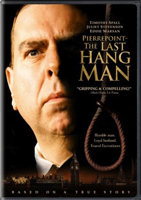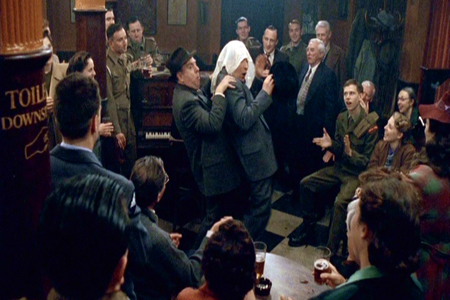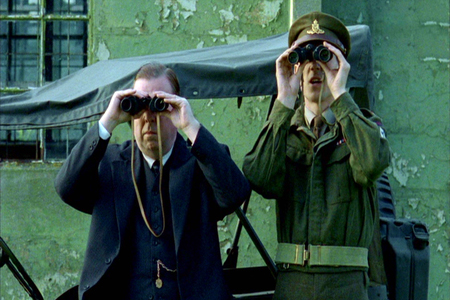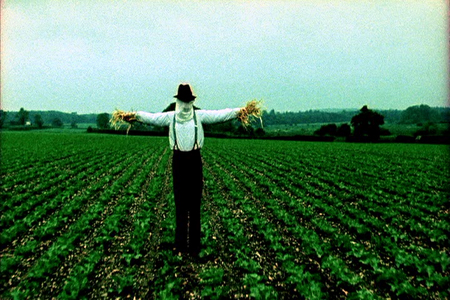
 BUY IT AT AMAZON: CLICK HERE!
BUY IT AT AMAZON: CLICK HERE!
STUDIO: IFC
MSRP: $19.95
RATED: R
RUNNING TIME: 90 minutes
SPECIAL FEATURES:
- Commentary with director Adrian Shergold
- Deleted scenes
- Trailer
The Pitch
A British Hangman’s Story.
The Humans
Timothy Spall, Juliet Stevenson, Eddie Marsan
The Nutshell
Alfred Pierrepoint was one of the most prolific hangmen in British history. A second generation hangman, Pierrepoint followed in the footsteps of both his father and his uncle, despite the objections of his mother who would warn him that it would cause him nothing but grief throughout his life. Between 1933 and 1955, he hanged at least 608 people, during which time he became a National hero when he hanged well over 200 Nazi war criminals. In 1956, Pierrepoint resigned over a dispute with the Home Office over his fees after his one of his last prisoners was reprieved.

Doing a little of the old in and out
The Lowdown
Timothy Spall (Wormtail from the Harry Potter films) stars in this movie, based on the life of Alfred Pierrepoint. The movie begins with a scene depicting the process of hanging a criminal, starting with the approach to the prisoner and the walk to the hangman’s noose where they would be executed quickly and efficiently. We meet Pierrepoint as he learns these methods and then we witness his personal life at home. His mother is disappointed in his choice and makes it clear that whatever he does as an executioner should never be spoken of in the home. We also remain in Albert’s shoes as he meets the woman who would become his wife.
We witness his first execution, following as he measures up the first prisoner, sets up the guillotine, and then leads the prisoner to their death. This scene plays out contrasting Albert with a fellow hangman as the execution occurs. When the second hangman freezes and is unable to continue, Albert takes over, leads the prisoner out quickly and takes care of business with little to no emotion. This scene, as well as the following scenes depicting more hangings, is played out in a style where the camera continuously transitions from Albert’s point of view to the prisoner’s point of view. It is masterful camera work that puts you both in the shoes of the prisoners, facing their certain doom, as well as in the shoes of Albert looking deep into the face of the condemned as they prepare to die.
It is in this area the movie becomes a slight masterpiece. You are shown both sides of this controversial encounter and, thanks to the masterful directing, can relate to both the condemned and the executioner. The movie does not tell you what to believe, it lets you make the judgment for yourself. It is a film that allows the viewer to make an intelligent decision based on what they are shown without the director telling you what he believes.

It was always a great time when the the girl’s school next door had their annual swin meet,
When we move on into the future, we see Albert with his wife and his friends. We witness the deaths and the tragedy of the hangings and then are allowed to contrast it with his personal life as a loving husband and an entertainer amongst his friends. No one knows what Albert does when he goes away on his business trips, as Albert is not allowed to make it public knowledge. There is a musical montage that lets us transition from the executions to Albert and his best friend Tish, as they do a vaudeville act for their friends at the pub. It really works well, showing the differences between Albert at work and Albert at play.
Albert considers his job as an executioner to be his opportunity to allow the prisoners to achieve a sort of redemption. He believes what he does allows the prisoners their final chance to atone for their sins. We see this in great detail as, while executing Nazi war criminals, he believes that once executed they are innocent once again, cleansed of their sins. Spall is magnificent in his role as Pierrepoint and his acting lets you empathize with him as he goes through his life executing one man after the next. They place him alongside assistants throughout the years that are able to play off his beliefs. The first assistant seems downdraught after the execution of a woman while a later assistant believes that the Nazi war criminals deserve to die horrible deaths. Through all this, Albert remains constant, quickly and efficiently taking lives while making sure the bodies are taken care of properly once the deed is done.
The fall of Albert from grace is handled with great care by the director. Albert’s cover is blown and he becomes a national hero during the execution of the war criminals. He then transforms into a monster to a public who is growing weary of capital punishment. When Pierrepoint is finally forced to execute an acquaintance, he finally starts to break. The acting here is masterful as you stand in his shoes while Albert’s mental state starts to collapse. Albert’s trials and tribulations are made all the more painful when we learn that his wife has grown to be more and more like Albert’s mother. When he needs her the most, she wants to hear nothing about his work. Albert finds himself all alone, and the movie drives you to that point with expert precision.

The look of the picture is solid, taking us through the dark grays of the executions to the hue tones of his home life. There is a well done change to black and white footage as we witness the war footage leading to the executions of the war criminals, and once again later news footage of the capital punishment protests. The music by Danny Cohen is perfect in the picture as well and is really solid in its placement in the film.
The movie ends with a question towards the use of capital punishment. While Albert Pierrepoint believed he was doing a good work most of the movie, towards the end of his life he finally decided nothing was gained through the executions. The movie was not made to give a specific opinion on capital punishment, however. The film’s sole purpose was to show the effects of capital punishment on the executioner himself. In that aspect, the movie is a great portrait of a complicated man’s life and is a provocative and expertly made film.
The Package
The cover is simple but effective. It is presented in 1:85:1 widescreen 5.1 Surround track. There is a director’s commentary. The director gives some interesting information about both the shoot and the actual history, but you mainly just listen to him telling you what you are viewing on the screen. There are also two deleted scenes included, one which extends the scene following the execution of his friend and its haunting effect on him. The second deleted scene is called Percy Plays Piano, and I am not sure where it relates to the movie. It also includes the theatrical trailer.

Here’s Jack!
8.6 out of 10